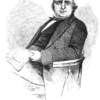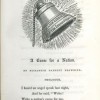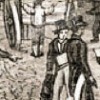
Jason Camlot, “The First Phonogramic Poem: Conceptions of Genre and Media Format, Circa 1888”
By 1888, the technology of the phonograph, and the medium of the phonograph cylinder, were established as market-ready. What was the imagined potential of this media technology in relation to known modes of communication and expression? This article recounts how “The Phonogram” or phonographic letter was prototyped from 1887 to 1892 through the efforts of Thomas Alva Edison and his London agent George Gouraud. Edison’s prototyping work and Gouraud’s efforts in developing recordings, scripts for phonogramic speeches, and formats for typographical transcription of the cylinder recordings represent a rich case study for documenting the nature and significance of their efforts to consolidate the medium and define the generic parameters of the phonogram (a speech recording) as a distinct form of global communication. By theorizing the relationship between late-Victorian concepts of medium, format and genre, respectively, and by interpreting the “first phonogramic poem” (16 June 1888) as an articulation of the meaning of sound recording at the historical moment that it arrived as a viable media technology, this article helps explain how sound recording technologies were imagined in relation to specific genres of communication. Drawing upon periodical literature, and documentation available through the Thomas Edison Papers archive—including phonogramic transcripts and speeches, marketing and foreign business strategies, patent applications, and packaging and design documents—this article explains, in particular, the generic and rhetorical protocols that informed the attempt to establish the phonogram as a new medium of intimate communication and international correspondence.

Janice Schroeder, “The Publishing History of Henry Mayhew’s London Labour and the London Poor”
Versions of Henry Mayhew’s massive social survey London Labour and the London Poor appeared in several publishing formats, including newspaper column, weekly serial, live stage show, and bound volume. This article traces the republication and remediation of London Labour alongside Mayhew’s repackaging of his interviews with London “street-folk” from 1849 onwards. I offer a succinct, accessible account of the complex publishing history of the text, from print newspaper column to digital edition.

Kristin Mahoney, “On the Ceylon National Review, 1906-1911″
The Ceylon National Review (1906-1911) was the official organ of the Ceylon Social Reform Society, an organization founded by the art historian Ananda Coomaraswamy in an effort to combat colonial influence and reinvigorate Ceylonese cultural production. Coomaraswamy also served as an editor at the Ceylon National Review. This essay focuses on the manner in which Coomaraswamy, in the essays he contributed to and solicited for the journal, fostered transethnic Ceylonese nationalism and anticolonial resistance as well as transnational engagement with British countercultural movements and radical thought. Paying particular attention to Coomaraswamy’s interest in socialist aestheticism, Theosophy, and British discourses concerning vegetarianism, I foreground the highly cosmopolitan inflection of Coomaraswamy’s brand of Ceylonese nationalism as expressed in the pages of the Ceylon National Review. In the essays he wrote and selected for publication in the periodical, Coomaraswamy integrated the discourses of anticolonialism and socialist aestheticism and allowed British and Ceylonese vegetarians and Theosophists to speak in relation to one another, engendering a rich and surprising form of Ceylonese nationalism inflected by late-Victorian radicalism.

Jonathan Mulrooney, “Edmund Kean, Event”
This article considers Regency actor Edmund Kean’s presence as a figure in the theatrical news of the day, arguing that Kean’s acting style, coupled with changes in periodical print culture, reframed the relation between the British theatrical tradition, the actor’s stage performance, and audience reception. Emphasizing an “illegitimate” grammar of representation characterized by gesture, mobility, and emotional transition, Kean enacted new forms of subjectivity that aligned with emerging modes of theatrical criticism to shape readers’ concepts of their own private experience and their imagined engagement with public events.

Denae Dyck and Marjorie Stone, “The ‘Sensation’ of Elizabeth Barrett Browning’s Poems before Congress (1860): Events, Politics, Reception”
Elizabeth Barrett Browning’s Poems before Congress paradoxically addresses a political event that never took place: a meeting of European powers to discuss the “Italian question” planned for January of 1860. Nevertheless, the collection addresses several momentous historical developments, including the Second Italian War of Independence in 1859, the intervention of Napoleon III of France in the Italian struggle, and the international conflict his intervention precipitated. Indeed, the book’s publication and the sensation it created in themselves constitute a plurality of events, since the collection appeared under differing titles in England and America and encountered differing responses in each country. Contrary to the still dominant critical view that the volume was almost universally denounced, its reception was shaped by diverse locations, shifting chronological contexts, and conflicting political affiliations. Close analysis of the reviews underscores the importance of these wider contexts, which influence what otherwise appear to be primarily literary or aesthetic judgements. At the same time, analysis of varying responses to not only “A Curse for a Nation” but also “Napoleon III in Italy” and other poems in the volume demonstrates a number of recurring points of contention. These include the collection’s title, the politics of interventions across national borders, English liberalism, the nature of democracy, cosmopolitanism versus nationalism, women writers in relation to politics, poetic form, and, most of all, EBB’s representation of Napoleon III—the issue that is front and centre in most of the 1860s reviews and that shaped, in turn, reactions to all the rest.

Marjorie Stone, “The ‘Advent’ of Aurora Leigh: Critical Myths and Periodical Debates”
Released by Chapman and Hall on 15 November 1856, Elizabeth Barrett Browning’s Aurora Leigh—a verse-novel and modern epic—set off literary, social, and political reverberations in Britain, North America, and Europe up to the end of the century. “The advent of ‘Aurora Leigh’ can never be forgotten by any lover of poetry who was old enough at the time to read it,” Algernon Charles Swinburne recalled in 1898. By 1900, Aurora Leigh—among much else the first extended poetical portrait of the professional woman writer in English literature—had appeared in more than twenty editions in England and as many in America. Given its innovative, generically mixed form and its controversial contemporary subject matter, it figured in debates over poetry and poetics, the nature of the realist novel, class divisions and social reform, women’s rights, religion, and the politics of nations. Contrary to the critical legend that Aurora Leigh was greeted by an “avalanche of negative reviews,” responses to it were diverse, shaped by periodical competition and differing print-culture, artistic, political, national and religious contexts. This essay surveys seldom-cited notices in the transatlantic daily and weekly press, analyzes critical debates on Aurora Leigh in the major British periodicals, and charts differing patterns in its American and European as compared to its British reception in the years immediately following its publication. It also indicates at points how debates over Aurora Leigh were intertwined with debates in the visual arts associated with the paintings of J. M. W. Turner and the Pre-Raphaelites.

Michelle Allen-Emerson, “On Magazine Day”
Magazine Day refers to the last day of every month when wholesale booksellers in London received the new monthly serial publications and prepared them for distribution. The monthly event determined the rhythm of the publishing industry for much of the nineteenth century and thus reflects the growing importance of serials to the nineteenth-century book trade.

Anna Maria Jones, “On the Publication of Dark Blue, 1871-73″
Dark Blue (1871–73) was a monthly magazine, edited by Oxford undergraduate John Christian Freund, which folded two years after a brilliant debut. During its brief run, it brought together a stunning list of literary and artistic contributors, including Dante Gabriel Rossetti, A. C. Swinburne, William Morris, Andrew Lang, Mathilde Blind, Sheridan Le Fanu, Simeon Solomon, and Ford Madox Brown, who produced aesthetically and sexually daring poetry, art, and criticism. However, it also strove to “appeal to the whole English-speaking public,” as Freund put it, and, thus, included much that might be described as middlebrow, even conservative. Whereas individual texts from Dark Blue, such as Le Fanu’s Carmilla, have received considerable attention, scholars have devoted very little sustained attention to the journal beyond noting its importance as an “artifact” in the history of the Pre-Raphaelite Movement and British aestheticism, and registering puzzlement at the journal’s eclecticism. This essay returns to Dark Blue to uncover common threads among dissimilar writers and artists. With particular attention to the journal’s commitments to transnationalism, I trace three intertwined threads—synesthesia, translation, and sexual dissidence—as they manifest in key texts by Swinburne, Solomon, Le Fanu, and others. Reading these texts in their original context not only demonstrates Dark Blue’s importance to early formations of aestheticism but also helps us to see how aestheticism connects with, rather than stands in opposition to, mid-Victorian culture.

Jane Stabler, “Religious Liberty in the ‘Liberal,’ 1822-23”
A survey of the negative twentieth- and twenty-first-century critical reception of the Liberal; a summary of the history of the journal and a re-evaluation of the philosophical and political coherence of the journal, focusing on its defence of religious liberty and suggesting that religious free thought is a previously overlooked component in the politics of liberalism. The criticism of doctrinal rigidity and advocacy of different forms of religious toleration evident in the four issues of the Liberal support the claim that the journal forms a lucid and intelligible cultural intervention.

Lorraine Janzen Kooistra, “The Moxon Tennyson as Textual Event: 1857, Wood Engraving, and Visual Culture”
By convention the launch of the so-called “golden age” of wood-engraved illustration in Britain, also known as “the sixties,” is Edward Moxon’s publication, in May 1857, of Alfred Tennyson’s Poems, with 54 wood-engraved illustrations designed by 8 artists, including the Pre-Raphaelites John Everett Millais, William Holman Hunt, and Dante Gabriel Rossetti. Although the Moxon Tennyson was neither a commercial nor critical success on first publication, before the decade was out its Pre-Raphaelite designs were considered a touchstone for artistic illustration, a reputation that continues today. Without disputing the significance of this aesthetic achievement, I want to shift critical focus to the Moxon Tennyson’s status as mass-produced work of art in the age of mechanical reproduction. My interest here is in how its visual communication was expressed through its reproductive technology at the historical moment of its production and reception. This essay re-positions the Moxon Tennyson as a textual event by reading it in the context of documentary, satiric, and artistic wood-engraved images selected from the crucial six-month period after its publication. By situating the Pre-Raphaelite illustrations for Tennyson’s Poems in relation to representations in the public press of such disparate events as the Art Treasures of the United Kingdom Exhibition in Manchester, the reportage on Indian uprisings at Meerut and Cawnpore, the Matrimonial Causes Act, and the Christy Minstrels show in London, I aim to show the complex ways in which the Moxon Tennyson was a worldly event, caught up in, and contributing to, ways of seeing and knowing in 1857.
